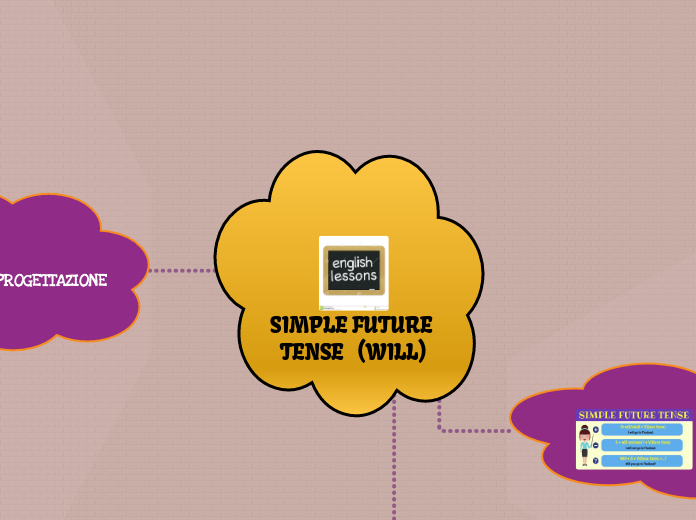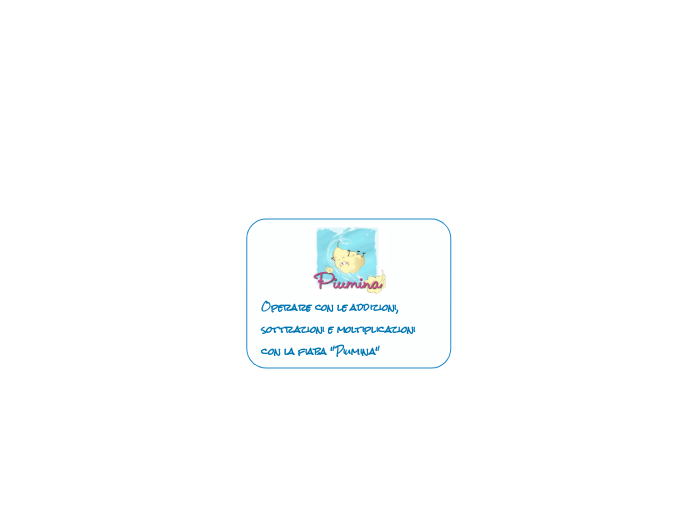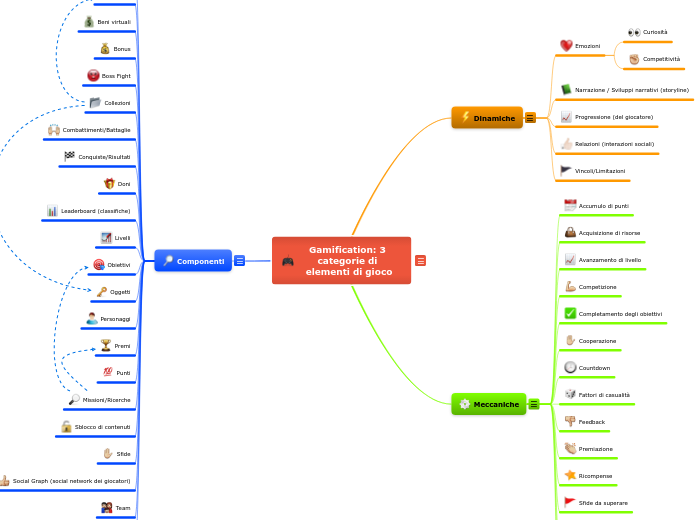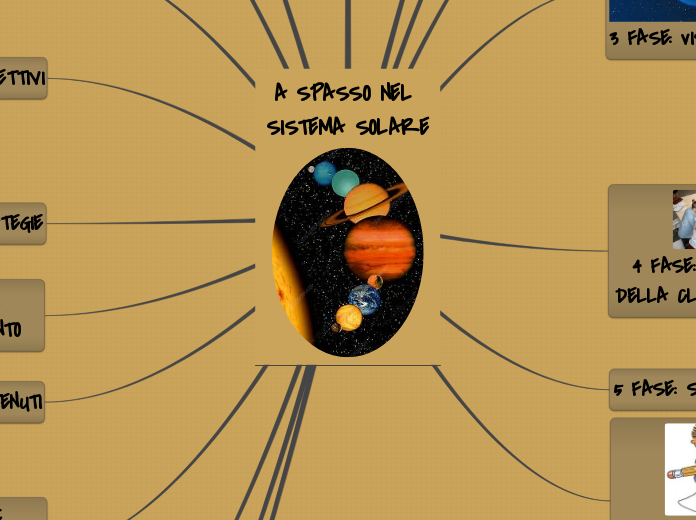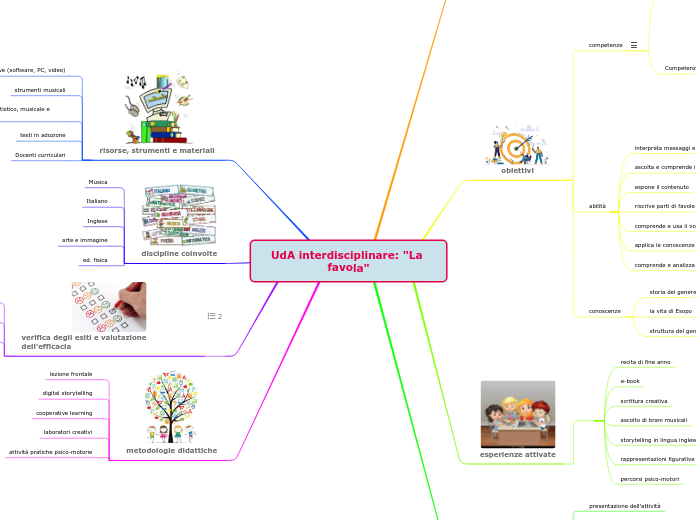SIMPLE FUTURE TENSE (WILL)
Tenses demonstrate the time of actions centered around the subject of the sentence. These actions are called verbs and change according to tenses.
PROGETTAZIONE
There are four Future tenses:
- Future Simple ('with Will' and 'with Going to')
- Future Continuous
- Future Perfect Simple
- Future Perfect Continuous
AUTOVALUTAZIONE
Analizzare i risultati conseguiti e i miglioramenti che possono essere effettuati
valutare i livelli di apprendimento raggiunti
VALUTAZIONE
Partecipazione,; interesse; impagno
Sviluppo delle competenze acquisite rispetto ai livelli di partenza
Osservazioni sistematiche
Elaborati scritti
STRUMENTI E SPAZI
Aula della classe
Libro di testo, immagini, foto, schemi. Pc, Lim
TEMPI
Un'ora di lezione
METODI
Lavori in piccoli gruppi
Utilizzo di immagini/foto in cui sono riportate situazioni significative e brevi dialoghi
Spiegazione della regola grammaticale attraverso la presentazione di un breve video con sottotitoli in italiano
Warming up : 5/10 minuti
COMPETENZE
Essere in grado di formulare domende e risposte adeguandosi alla situazione
Esprimere stati d'animo.
ABILITA'
Potenziare le abilità nel reading, listening, speaking e writing nell'uso delle azioni future
- Reading: leggere una conversazione e comprendere le azioni future
- Listening: comprendere un dialogo informale tra i ragazzi.
- Speaking: sulla base di situazioni date, offrire aiuto al proprio amico.
- Writing: rispondere ad una mail scrivendo riflessioni sui propri progetti futuri (extra activity)
OBIETTIVI SPECIFICI
Future Perfect Simple is used for:
- an action that will continue up until a point in the future
- an action that finishes just before another time or action in the future
Some adverbs used with Past Perfect Continuous for future actions:
- for
- since
- next week
- next month
- next year
Produrre brevi testi orali e scritti per esprimere le emozioni
Saper esprimere in lingua informazioni afferenti alla sfera personale
Structure:
Will + Subject + Have Been + Verb-ING
e.g. How long will they be working on that project next week?
Consolidare/potenziare: vocaboli, strutture e funzioni linguistico-comunicative legate al mondo delle emozioni
Structure:
Subject + Won’t Have Been + Verb-ING
e.g. They won’t have been working on that project for two years next week.
Apprendere la forma affermativa, negativa, interrogativa di Will
Structure:
Subject + Will Have Been + Verb-ING
e.g. They will have been working on that project for two years next week.
FINALITA'
Future Perfect Simple is used for:
- an action that will be finished by a particular time in the future
- an action that starts before and continues up to another action or time in the future
- an action that will finish before a certain time in the future, but it is not known exactly when
Adverb used with Future Continuous:
- tomorrow (e.g. tomorrow by 7)
Comprendere ed esprimere le emozioni legate ai diversi contesti di vita reale
Structure:
Subject + Will Have + Past Participle
e.g. I will have met my friend form United States by this time tomorrow.
Stimolare negli alunni l'acquisizione di una maggiore conoscenza e consapevolezza delle emozioni proprie e altrui
Structure:
Subject + Won’t Have + Past Participle
e.g. I won’t have met my friend form United States by this time tomorrow.
PREREQUISITI
Future Continuous is used:
- for an action that is likely to happen in the future and continue for an expected length of time
- for an action that will be in progress at some point in the future
- for action verbs (e.g. running)
- for predictions about future events
Adverb used with Future Continuous:
- tomorrow (e.g. tomorrow at 5 o'clock)
Pronomi personali
Structure:
Subject + Won’t Be + Verb-ING
e.g. He won’t be having fun at the party.
Examples
Type in your own examples or you can also choose from the examples below.
Form of word "to be":
I will not be beingYou will not be beingHe/She/It will not be beingWe will not be beingYou will not be beingThey will not be being
Form of word "to have":
I will not be havingYou will not be havingHe/She/It will not be havingWe will not be havingYou will not be havingThey will not be having
Lessico e vocabolario su: feelings and emotions
Vocaboli che esprimono stati d'animo e sentimenti: es happy, nervous, stressed, calm, confident, upset, angry, sad, guilty..ecc.
Structure:
Subject + Will Be + Verb-ING
e.g. You will be having fun at the party.
DESTINATARI
Future Simple is used:
- to predict an event in the future
- to invite
- to give orders
- to express willingness
- for actions that have not yet occurred but that will occur at a future date
Classe III F
Gruppo classe con alunna con ipoacusia percettiva bilaterale, protesizzata
Future Simple with 'will'' is used:
- to predict the future
- for something with absolute certainty
- when we're talking about a decision at the moment of speaking
- promises, requests, refusals, offers
- future facts
Some adverbs used with Future Simple:
- tomorrow
- next week
- next month
- next year
AUTOVALUTAZIONE ALUNNI
Questionario di autovalutazione
- Che cosa ho imparato?
- Ho svolto l'esercitazione in totale autonomia oppure è stato necessario l'intervento dell'insegnante?
- In che cosa ho avuto difficoltà?
- in che cosa mi sento più sicuro/a o competente?
- Come valuto il mio comportamento? ( attenzione, impegno, relazione, organizzazione del lavoro, partecipazione...)
FASI OPERATIVE
There are four Past tenses:
- Past Simple
- Past Continuous
- Past Perfect Simple
- Past Perfect Continuous
VERIFICHE
Esercizi con Wordwall
- https://wordwall.net/resource/31278524
- https://wordwall.net/resource/31277948
- https://wordwall.net/resource/31277572
Esercizi con Kahoot
https://create.kahoot.it/share/future-simple-will/9acbecf6-8a0c-473e-9e72-d448109a167c
Past Perfect Continuous is used:
- for an action that started in the past and continued up to another point in the past
- to show cause and effect
Some adverbs used with Past Perfect Continuous:
- since (e.g. since yesterday)
- for (e.g. for 10 years, for 6 months)
Divisione della classe in piccoli gruppi: 2/3 alunni.
- Svolgimento di esercizi di completamento e di comprensione.
- Impostazione di brevi dialoghi con i compagni, con l'uso di Will
Structure:
Subject + had been + Verb-ING
e.g. They had been talking for over an hour before I arrived.
Past Perfect Simple is used for:
- an action that began in the past and is still going on at the moment of speaking
- an action that continued before and after another action
- a change of mind
- an action happening repeatedly in the past
The Past Perfect tense is not normally used alone. It is used to denote the earlier of two past actions. We use Past Simple for the latter action.
Some adverbs used with Past Perfect Simple:
- already, before, ever, never
- once, twice, yet
- just, up to then
- for, since
Riconoscere nelle immagini e nelle foto che riportano i diversi stati d'animo o brevi dialoghi, le espressioni di uso corrente.
Structure:
Subject + had + Past Participle
e.g. They had already met Julia before the party.
Past Continuous is used for:
- an action that happened before another action in the past
- an action that started in the past and continued up to a given time in the past
- an action done several times up to a point in the past and continued to do after that point
- an action that happened in the past but is important at the time of reporting
Some adverbs used with Past Continuous:
- always, only, never, ever, still, just
Prestare attenzione al video proposto "Simple future with Will" sulla regola grammaticale, proiettato con la LIM, richiedendo eventuali spiegazioni.
Structure:
Subject + was/ were + Verb-ING
e.g. You were studying when she called.
FASE
Past simple expresses:
- an action that happened in the past and has no connection with the present
- an action that happened once in the past
- an action that happened regularly in the past
- an action that was true for some time in the past
- an event or action that already occurred
- an action that is finite - has both a starting and a stopping point
Some adverbs used with Past Simple:
- yesterday
- last month, last year
- ago (e.g. two days ago)
- in (e.g. in 1997)
- never, always, seldom, often, frequently, occasionally, once, twice
Sfruttare la fase del Warming up per rivedere i vocaboli e il lessico già noti su emozioni e sentimenti.
Structure:
Subject + Verb in Past Simple (2nd form)
e.g. They lived in Spain three years ago.
